What Meaning Is Behind the Cross Heart Symbol?
The cross with a heart symbol intricately melds the theological concepts of Christ's sacrifice and divine love. Historically rooted in early Christian iconography, it surfaced prominently in medieval and Renaissance art to express God's boundless love through Jesus' crucifixion.
This symbol portrays the intersection of redemptive suffering and unconditional love, embodying the core of Christian faith. Beyond its religious origins, it encapsulates universal themes of love and sacrifice, extending its significance to various cultures and artistic expressions.
For those exploring the deeper facets of this symbolism, further insights await.
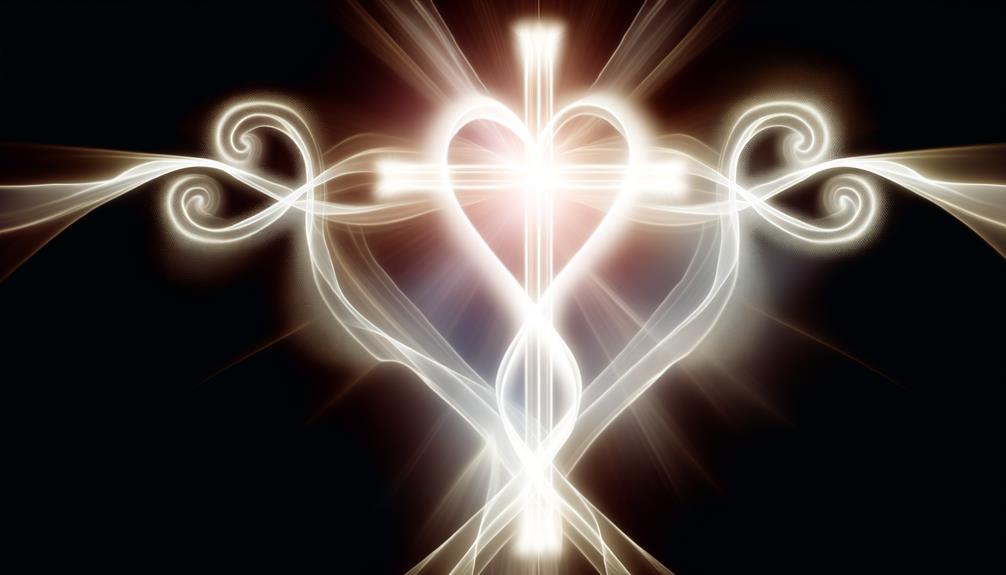
Key Takeaways
- Represents the combination of Christ's sacrifice (cross) and divine love (heart).
- Highlights God's boundless love and ultimate sacrifice for humanity's salvation.
- Symbolizes the intersection of divine love and redemptive suffering in Christianity.
- Serves as a reminder of Jesus' omnipresent love and willingness to endure suffering.
- Embodies the theological principles of unconditional love (agape) and sacrificial nature.
Historical Origins
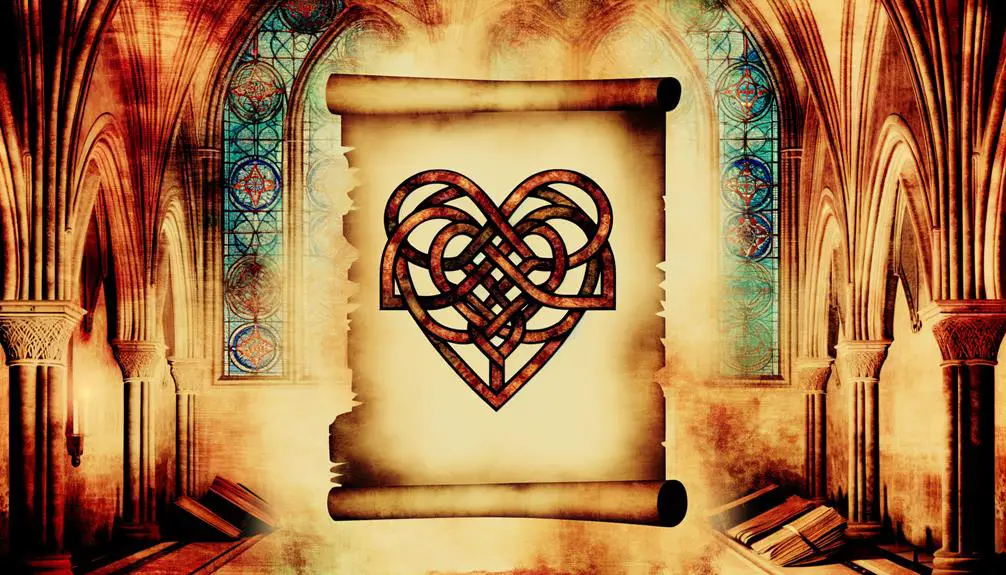
Tracing the historical origins of the cross with a heart symbol requires examining its roots in early Christian iconography and theological symbolism. This motif can be traced back to medieval Europe, where it often appeared in illuminated manuscripts and ecclesiastical art.
The cross, emblematic of Christ's sacrifice, combined with the heart, an age-old symbol of divine love and piety, created a powerful visual representation of faith. The fusion of these elements was not merely artistic; it reflected theological principles that emphasized God's love manifested through the crucifixion.
Additionally, the Renaissance period saw this symbol's proliferation in religious texts and artifacts, reinforcing its significance in Christian thought and practice. Understanding its origins provides a foundation for exploring its deeper meanings.
Religious Significance
In the domain of Christian theology, the cross with a heart symbol serves as a profound representation of the intersection between divine love and the sacrificial nature of Christ's crucifixion.
This emblem encapsulates the essence of agape—unconditional love—and aligns it with the redemptive suffering of Jesus.
The heart signifies God's boundless love for humanity, while the cross signifies the ultimate sacrifice made for mankind's salvation.
This duality underscores the belief that divine love is manifested most fully in the act of self-sacrifice.
Theologically, it emphasizes the integration of love and suffering as central to Christian faith, offering a visual and conceptual synthesis that deepens believers' understanding of the mysteries of redemption and divine compassion.
Cultural Interpretations
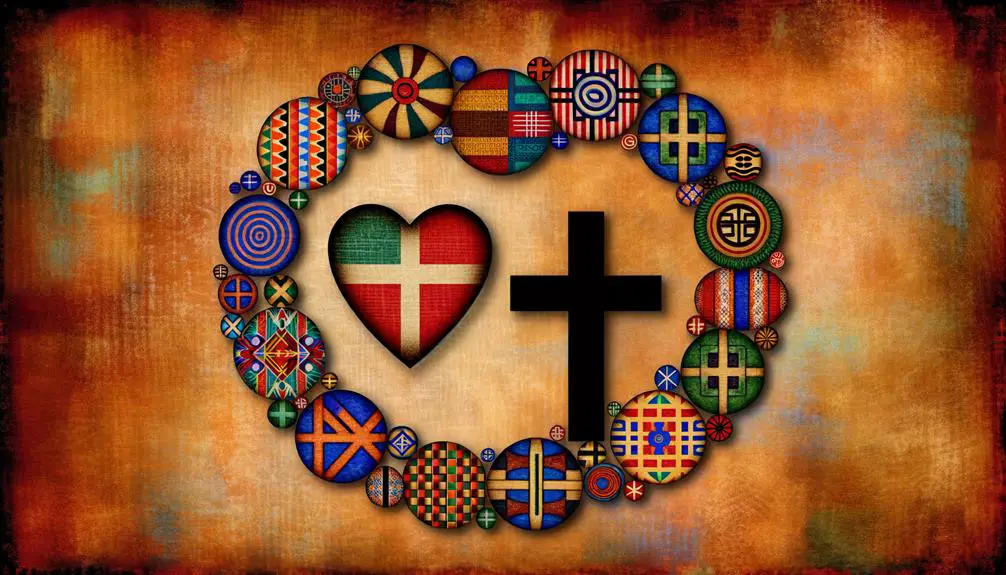
Examining the cultural interpretations of the cross with a heart symbol reveals its multifaceted significance beyond its religious roots. This symbol encapsulates themes of Christian love and sacrifice, while modern interpretations have expanded its meaning to encompass various expressions of personal and collective identity worldwide.
Christian Symbolism Significance
The cross with a heart symbol, often referred to as the Sacred Heart, embodies profound theological implications within Christian symbolism, representing Jesus Christ's divine love and sacrifice for humanity.
This iconography portrays the heart as a vessel of immense compassion and mercy, encapsulating the core tenet of Christian doctrine: unconditional love.
Historically, the Sacred Heart has been depicted in various forms, accentuating elements like thorns and flames, which signify suffering and ardor, respectively.
Contextually, the symbol serves as a reminder of Jesus' omnipresent love and His willingness to endure suffering for humankind's redemption.
The cross, intersecting with the heart, further emphasizes the inseparable connection between Christ's passion and His eternal love for mankind, forming a central motif in Christian art and devotion.
Love and Sacrifice
Across diverse cultures, the cross with a heart symbol transcends its Christian origins, embodying universal themes of love and sacrifice that resonate deeply with various human experiences and spiritual beliefs. This powerful iconography is interpreted through multiple lenses:
- Mythological Narratives: Ancient mythologies often associate the heart with divine love and the cross with transformative sacrifice.
- Interpersonal Bonds: Many cultures depict the cross with a heart in contexts that highlight the sacrificial nature of true love in relationships.
- Spiritual Altruism: The symbol is frequently employed in spiritual teachings to emphasize selflessness and the ultimate sacrifice for the greater good.
These interpretations illustrate how the cross with a heart transcends religious boundaries, enriching global spiritual and emotional discourse.
Modern Interpretations Worldwide
In contemporary contexts, the cross with a heart symbol is interpreted through a myriad of cultural lenses, each imbuing it with distinct theological and emotional significance.
Within Western cultures, it often signifies the intersection of divine love and human salvation, resonating deeply within Christian communities.
In Latin American regions, this symbol frequently appears in folk art, embodying a fusion of indigenous spirituality and Catholic iconography.
Meanwhile, in East Asian contexts, the symbol may be adapted to represent universal love and moral virtues, detached from its Christian origins.
Across these diverse interpretations, the cross with a heart remains a potent emblem of transcendent love, bridging theological doctrines and cultural narratives, enhancing its global resonance and multifaceted meanings.
Symbolism in Art
The cross with heart symbol holds a profound position in art, demonstrating a rich historical artistic significance that mirrors the evolving cultural interpretations over centuries.
This symbol has been rendered through various mediums and techniques, each adaptation reflecting the theological and emotional nuances of its time.
Analyzing these artistic renditions offers insights into the intersection of faith, art, and cultural identity.
Historical Artistic Significance
Examining the historical artistic significance of the cross with a heart symbol reveals its deep roots in religious iconography and its evolving interpretations across various cultures and epochs. This symbol, often seen in Christian art, encapsulates themes of divine love, sacrifice, and redemption. Analyzing its presence in different artistic periods offers insights into its multidimensional meanings.
- Medieval Art: Emphasized the heart as a symbol of Christ's sacrificial love, often depicted in illuminated manuscripts.
- Renaissance Art: Focused on the heart as a metaphor for human devotion, merging classical and Christian motifs.
- Baroque Art: Highlighted emotional intensity, using the heart-cross symbol to evoke spiritual fervor and piety.
This analysis underlines the symbol's theological depth and artistic versatility.
Cultural Interpretations Evolved
Cultural interpretations of the cross with a heart symbol have evolved substantially, reflecting a rich tapestry of theological and artistic meanings across different periods and regions.
Initially rooted in Christian iconography, this symbol has transcended its original context, embodying universal themes of love, sacrifice, and spiritual union.
During the Renaissance, artists used it to signify divine love and redemption.
In modern times, it has been adapted by various movements, including Romanticism and contemporary spiritual practices, to convey personal faith and emotional depth.
Each era imparts its unique cultural and theological nuances, demonstrating the symbol's dynamic capacity to resonate with human experiences of the sacred and the profane, thereby continually enriching its interpretative layers.
Mediums and Techniques Used
In exploring the symbolism of the cross with a heart in art, diverse mediums and techniques have been employed to accentuate its theological and emotive dimensions. Artists leverage these methods to convey profound spiritual truths and human emotions.
Notable approaches include:
- Stained Glass: Enhances the interplay of light and color, symbolizing divine illumination and love.
- Sculpture: Utilizes depth and form to evoke the tangible presence of divine sacrifice and compassion.
- Iconography: Employs stylistic elements to narrate theological narratives, emphasizing the unity of divine suffering and human affection.
Each medium and technique provides a unique lens through which the cross with a heart can be interpreted, deepening our understanding of its rich, multidimensional symbolism.
Modern Uses
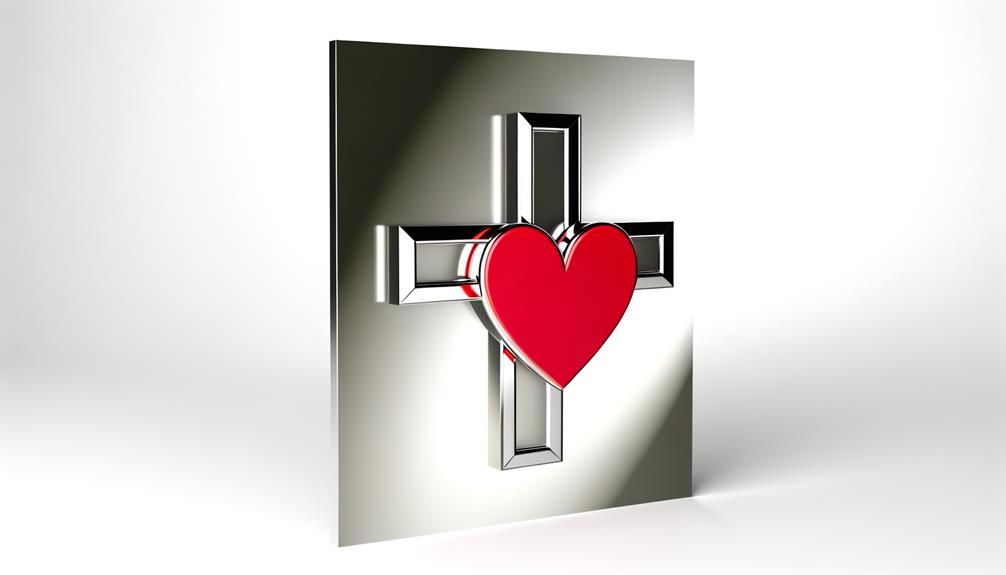
Integrated into contemporary culture, the cross with heart symbol finds diverse applications ranging from fashion accessories to digital communication, reflecting both aesthetic appeal and profound theological significance. Its modern uses underscore the synthesis of traditional faith with contemporary expression, allowing individuals to convey complex ideas through a simple emblem.
| Application Area | Example |
|---|---|
| Fashion Accessories | Necklaces, bracelets, earrings |
| Digital Communication | Emojis, social media posts |
| Home Décor | Wall art, sculptures |
| Religious Merchandise | Bible covers, bookmarks |
In fashion, this symbol is often featured in jewelry, symbolizing faith and love. In digital spaces, it serves as a shorthand for conveying spiritual and emotional sentiments. These uses illustrate how the cross with heart continues to resonate meaningfully in a modern context.
Tattoos and Body Art
Tattoos featuring the cross with heart symbol serve as a permanent evidence to an individual's intertwined expressions of faith and love, embodying profound theological significance. These tattoos often represent a personalized covenant between the bearer and their spiritual beliefs, intertwining the emotive and the divine.
The symbolism resonates deeply with those seeking to manifest their dedication visibly. The following elements are commonly associated with this tattoo design:
- Faith and Devotion: Expressing unwavering commitment to religious beliefs.
- Love and Compassion: Signifying an eternal bond of love, often divine love.
- Spiritual Journey: Illustrating a personal spiritual path or transformation.
Jewelry and Accessories

Jewelry and accessories featuring the cross with heart symbol serve as tangible expressions of faith and love, merging aesthetic appeal with profound theological meaning. These items are not mere adornments but are imbued with significant spiritual symbolism.
The cross represents Christ's sacrifice, while the heart signifies divine love. When combined, they encapsulate the essence of Christian faith—sacrificial love and redemption. Worn as necklaces, bracelets, or rings, these pieces serve as daily reminders of one's spiritual commitments and beliefs.
Their presence in fashion extends the reach of theological concepts into everyday life, allowing wearers to carry their faith visibly and meaningfully. These accessories serve both as personal devotionals and as public declarations of one's faith journey.
Cross and Heart in Literature
In literature, the cross combined with the heart often emerges as a potent symbol intertwining themes of faith and love. This amalgamation serves to highlight the sacrificial nature of love, echoing theological notions of Christ's sacrifice.
Romantic literature, in particular, frequently employs this metaphor to underscore the profound interconnectedness of spiritual devotion and emotional commitment.
Symbolism in Romantic Literature
Throughout romantic literature, the juxtaposition of the cross and heart symbols often serves to explore themes of sacrificial love, spiritual unity, and the profound intersection between faith and emotion. This dual symbolism is employed to evoke a deeper understanding of the human condition and the transformative power of love.
Key elements include:
- Sacrificial Love: Characters often endure great trials, symbolized by the cross, to demonstrate the depth of their affection.
- Spiritual Unity: The heart and cross together underscore the idea that true love transcends the physical domain, achieving a sacred union.
- Emotional Faith: The integration of these symbols reflects a belief in love's capacity to inspire spiritual and emotional growth.
This interwoven imagery enriches the narrative, infusing stories with theological depth.
Faith and Love Intertwined
The intertwined symbolism of the cross and heart in literature reveals a profound theological narrative where faith and love are not merely coexisting but are deeply enmeshed, reflecting the belief that true love inherently possesses a spiritual dimension. In literary works, this integration often highlights the divine nature of love, suggesting that genuine affection transcends the earthly domain and aligns with a higher, spiritual purpose.
Authors employ this motif to underscore characters' journeys toward spiritual enlightenment, where the cross signifies faith's trials and the heart symbolizes the purity of love. This duality serves a didactic purpose, teaching readers that steadfast faith can amplify love's authenticity, thereby fostering a more holistic spiritual experience.
Metaphor for Sacrifice
How does the confluence of the cross and heart in literature serve as a profound metaphor for sacrifice, intertwining themes of love's purity with the enduring trials of faith? This symbolic fusion often evokes a multitude of interpretations that resonate deeply within theological and literary contexts.
The heart signifies unconditional love, while the cross epitomizes ultimate sacrifice and redemption. Together, they offer a potent narrative vehicle for exploring the complexities of human devotion.
- Symbolism of Martyrdom: Reflects the intersection of personal sacrifice and universal salvation.
- Endurance of Love: Depicts love as an enduring force, capable of overcoming immense suffering.
- Spiritual Transformation: Suggests that true sacrifice leads to profound spiritual growth and enlightenment.
This emblem encapsulates a rich tapestry of sacrificial love and faith.
Psychological Impact
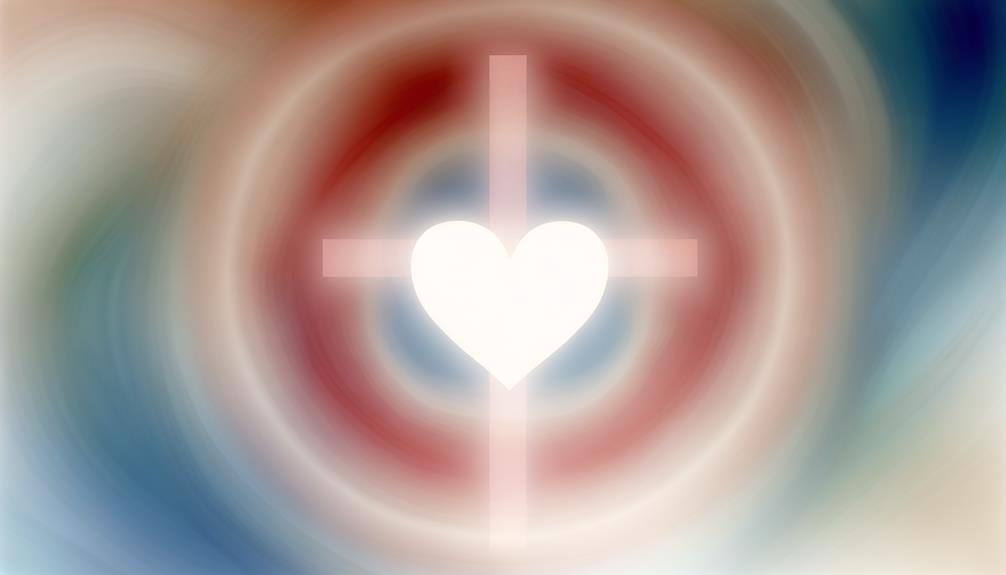
Understanding the psychological impact of the cross with heart symbol necessitates examining its deep-rooted association with spiritual themes of love, sacrifice, and redemption.
This symbol often evokes profound emotional responses, fostering a sense of connection to a higher power and instilling hope amidst adversity.
The heart, emblematic of love, juxtaposed with the cross, a representation of sacrifice, creates a powerful narrative that resonates deeply with individuals.
Theological interpretations suggest that this symbol serves as a reminder of divine love and the ultimate sacrifice made for humanity's redemption.
This duality can lead to an enhanced sense of spiritual well-being, offering comfort and solace in times of personal struggle, and reinforcing the human capacity for enduring compassion and selflessness.
Personal Stories
In exploring personal stories, individuals often recount transformative experiences where the cross with heart symbol served as a profound source of spiritual insight and emotional healing. These narratives highlight the symbol's potent amalgamation of faith and love, which resonates deeply on both personal and communal levels.
- Testimonies of Reconciliation: Many describe moments of forgiveness and reconciliation, facilitated by the symbol's reminder of divine love and sacrifice.
- Healing Journeys: Stories often include emotional and physical healing, where the symbol acted as a focal point for prayer and meditation.
- Spiritual Epiphanies: Individuals report profound spiritual epiphanies, interpreting the symbol as a divine message of hope and redemption.
These accounts collectively underscore the cross with heart symbol's enduring theological significance.
Conclusion
In sum, the cross with heart symbol encapsulates a rich tapestry of historical, religious, and cultural meanings.
Despite potential objections that such symbols may lack universal significance, their enduring presence in art, literature, and personal adornment attests to their deep psychological and theological resonance.
This emblem harmonizes notions of faith, love, and sacrifice, offering a multifaceted representation that continues to inspire and evoke profound emotional responses across diverse contexts.






